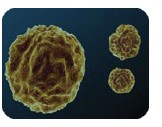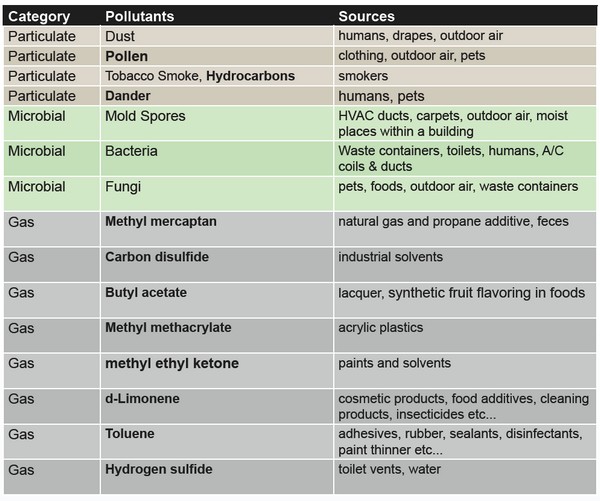

Microbial pollution is a key element of indoor air pollution. It is caused by hundreds of species of bacteria and fungi, in particular filamentous fungi (mold), growing indoors when sufficient moisture is available, noted the World Health Organization in its report "WHO Guidelines for Indoor Air Quality: Dampness and Mold, published July 16, 2009
"Problems of indoor air quality are recognized as important risk factors for human health in both low-income and middle- and high-income countries. Indoor air is also important because populations spend a substantial fraction of time within buildings. In residences, day-care centres, retirement homes and other special environments.
Indoor air pollution affects population groups that are particularly vulnerable due to their health status or age. Microbial pollution involves hundreds of species of bacteria and fungi that grow indoors when sufficient moisture is available. Exposure to microbial contaminants is clinically associated with respiratory symptoms, allergies, asthma and immunological reactions," according to the World Health Organization in its report WHO Guidelines for Indoor Air Quality: Dampness and Mould, published July 16, 2009.
"Black mold and toxic mold are causes of Indoor Air Pollutions and Indoor Water Pollutions. It can be in any indoor places like home, offices and buildings. It can be behind those beautifully painted walls in the office, nice-colored carpets, cabinets, walls, ceilings and even in cleanly maintained kitchen at home"
Ninety four percent (94%) of all respiratory ailments are caused by polluted air according to the American Medical Association, which also reported that one-third of our national health bill is for causes directly attributable to indoor air pollution such as toxic mold damage and black mold problem.
The U.S. Government Environmental Protection Agency (EPA) warns people that "Most people are aware that outdoor air pollution can damage their health but may not know that indoor air pollution can also have significant effects. EPA studies of human exposure to air pollutants indicate that indoor air levels of many pollutants may be 2-5 times, and occasion more than 100 times, higher than outdoor levels. These levels of indoor air pollutants are of particular concern because it is estimated that most people spend as much as 90% of their time indoors. In recent years, comparative risk studies performed by EPA and its Science Advisory Board (SAB) have consistently ranked indoor air pollution among the top five environmental risks to public health."
Black mold and toxic mold problems should not be taken for granted because it is a serious problem which can cause mold damage. When molds are growing on some part of your home, it is like a cancer, it can spread all over your home through its mold spores and before you know it, it has already wrecked your entire house. Mold sucks out the strength of your home and then make your entire dwelling place dangerous to live in due to toxic mold contamination problem.
Indoor air pollutants fall into three main categories

Particulates
Over 99% of particulate matter is invisible to the naked eye and
easily infiltrates the lungs.
On average,
every cubic foot of untreated indoor air
contains 20 million particles.
 Microbes
Microbes
Includes three major types of organisms: bacteria, protozoa, and
fungi/mold. Most of these contaminants
rely on a humid and moist environment
for growth & survival. Some molds produce
certain chemicals, such as mycotoxins
and Volatile Organic Compounds (VOCs).
Gases & Odors
Indoor gases, such as
benzene, formaldehyde, and hydrogen
sulfide, are released into the air from
furniture, carpets, hair sprays, cleaning
chemicals, insulation, and pesticides.
Gases include VOCs which evaporate
into the air easily. Odors are often composed of VOCs or other
gases.
The chart below shows a partial list of
the most common air pollutants and their sources. Knowing
the sources of certain pollutants help you later in deciding the
best areas to conduct your IAQ testing. Knowing the sources
of contaminants also helps you to determine the best method
to eliminate them.

Are the contaminants we learned about above
present in our homes and
buildings?
Perhaps the biggest cause of poor IAQ today is
energy conservation. We seal our homes and buildings as
tight as possible to keep our heating
and cooling costs down. This causes
lack of ventilation or fresh air from
entering the building. Instead of
fresh air being introduced, the same
contaminated air keeps circulating
through the already contaminated
structure. With each cycle the
air becomes more contaminated.
When you take a shower or boil
water you fill the air with more moisture. In return you create the perfect breeding ground for mold, bacteria, fungus and other microorganisms. The
moisture builds up inside your central heating ventilation and
cooling (HVAC) unit where more mold and bacteria continue
to grow. As the air passes through your ducts the mold and
bacteria sticks to the ducts. It begins to grow in this low light,
moist environment. Over time the growth becomes worse.
With every cycle your HVAC unit runs it pollutes your home or
building even more by spreading the contaminants throughout
the entire structure.
Mold and bacteria are not
your only concerns.
Pretend you have a sister
or daughter who has come
down with a cold. During
the first day of her cold she
is still able to attend school
and participate in activities
at home. The first symptoms
she has is a runny nose and a cough. At school that day she is
constantly sneezing and coughing. When she goes home you
play games, help her with homework and eat dinner together.
The whole time she is still coughing and sneezing. The virus
becomes aerosolized for you to inhale. The virus lands on your
food at the dinner table. As she wipes her nose with a tissue
the virus gets on her hands and then you share a pencil during
homework. She transfers the virus from her to you in many
ways. Before you know it you have the same cold and several
other students at school have also been infected.
There are several other pollutants that won't
cause a cold or an infection, but can cause
serious allergic reactions. When a door opens or
your dog comes inside pollen also comes inside.
There are many sources for dust and dander.
The main source is you. You shed billions of dead skin cells
everyday. Your carpet, furniture, household cleaners, the paint
on your walls, your toys, your bedding, cosmetics, perfumes,
and virtually everything in your home and most buildings today
releases some type of VOC or gas into your air.
Another common pollutant present in many homes
today is cigarette smoke. A single cigarette alone
releases over 4,000 chemicals in your air. Many
places of business no longer allow smoking in the
building or on their property, but many adults still
smoke in their homes. This places their children and other
people in their home at risk.
Carpet is one of the biggest and most common
sources of air pollutants.
Carpet covers over 70%
of the floors in America. Most new carpet contains
over 31 chemicals including: volatile organic
compounds, styrene, 4-PC, and formaldehyde.
Some of these chemicals are considered carcinogens. They
can cause severe, even deadly neurotoxin reactions. Some
carpets are glued directly to the floor using strong adhesives
containing harmful chemicals. The chemicals in carpet are
not the only pollutants. Overtime we spill liquids, foods, and
other everyday items on the carpet. We track in pollens, molds
etc. from outdoors and they become imbedded in the carpet.
We cough and sneeze on the carpet. We along with our pets
leave dead skin behind and much more. All which equates to
one giant sized area with almost every contaminant known to man trapped within.
This is now another
perfect breeding
ground for mold and
bacteria. Even if you
clean your carpets
often you only clean
the surface. All the
contaminants lurk
deep within and
resurface quickly. In fact, the act of cleaning your carpet
increases the moisture under your carpet, resulting in a
dark, warm, moist environment to grow more mold and
bacteria. You thought your bathroom was gross. Think about
it tonight as you lay and play on your soft comfortable carpet.
Another large pollution source often overlooked
is the ducts and coils of your HVAC system.
We have covered how mold, bacteria and
other contaminants build up in your ducts. The
chemicals emitted by your carpet and other
items circulate through homes and buildings
via air conditioners as well. Of course none of
us want to live or work without cool air in the
summer and warm air in the winter. Therefore,
removing your HVAC system and all ducts is not an option.
Generally, cleaning your coils and ducts at least once a year is recommended. This greatly reduces the amount
of dust, mold, bacteria, etc., circulating through a home or
building. Many companies specialize in this cleaning process.
There are other things you can do to help reduce
pollutants. Anytime you cook, do laundry, or take a shower or bath you should turn on the exhaust
vents in your kitchen, bathrooms, and laundry
room to help remove moisture from the air. This
helps to control the growth and spreading of
mold and bacteria. Turning on the exhaust vents
when you use high VOC products, such as hair
spray, helps to eliminate pollutants.
Not using an over abundance of cleaning products, cosmetics, perfumes,
air freshener sprays, etc., reduces the amount of chemical
pollutants present in your air. It is also a good idea to open your
windows as often as possible to allow old stale air to escape
and introduce new fresh air into your home or other buildings.
What should a person do about all other pollutants left behind
after removing the above sources? With humans and pets
being two of the biggest sources in homes and buildings
there must be other options. We cannnot exactly make ourselves
disappear to have clean air.
|